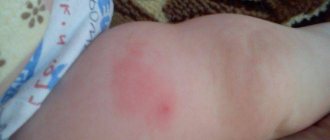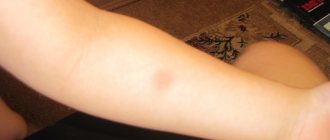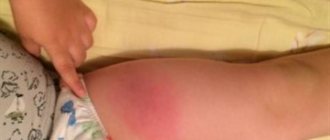Results in children and adults and types of reactions
There are several types of reactions to the Mantoux test:
- negative;
- doubtful;
- positive;
- false positive.
Negative
In both adults and children, a negative reaction is considered to be the absence of compaction and redness at the injection site. Sometimes there is a slight reaction to the injection itself - no more than 1 mm in transverse size. This reaction means that there is no tuberculosis infection in the human body, he has good immunity from tuberculosis. This is the most successful type of reaction.
Doubtful
In both adults and children, this reaction ranges in size from 2 to 4 mm. If there is no compaction, but there is redness, this is also a questionable reaction. Most often, it is actually equated to negative. Perhaps this is how a recent infectious disease or mild allergy makes itself felt. If you accidentally wet or rub the injection site, the reaction will also be questionable.
Photo 1. Mantoux vaccination with redness but no thickening is usually considered a questionable reaction.
Positive
This group includes 4 types of reactions:
- weakly positive (compaction from 5 to 9 mm);
- moderate intensity (from 10 to 14 mm);
- pronounced (from 15 to 16 mm in children, from 15 to 20 mm in adults);
- hyperergic (from 17 mm or more in children, from 21 mm or more in adults).
Important! There is a vesiculonecrotic reaction. It appears rarely and requires mandatory consultation with a phthisiatrician.
With this reaction, skin necrosis occurs at the injection site, and pustules form.
Any positive reaction automatically puts a person at risk. But she does not say that the person has tuberculosis. If, when checking the results, the nurse sees the need for additional diagnostics, the person will be referred to a doctor.
Usually, a doctor is sent only if the papule size is more than 15–17 mm. The fact of the disease is established during subsequent tests. But a positive reaction in itself does not bode well.
False positive
This reaction is no different from a positive one. It is characterized by the same dimensions and external manifestations. A reaction is called a false positive if it is known for sure that there is no Koch bacillus in the human body. False results are usually caused by some other infection (including a recently treated one), allergies, skin disease, exposure to water, or scratching the injection site.
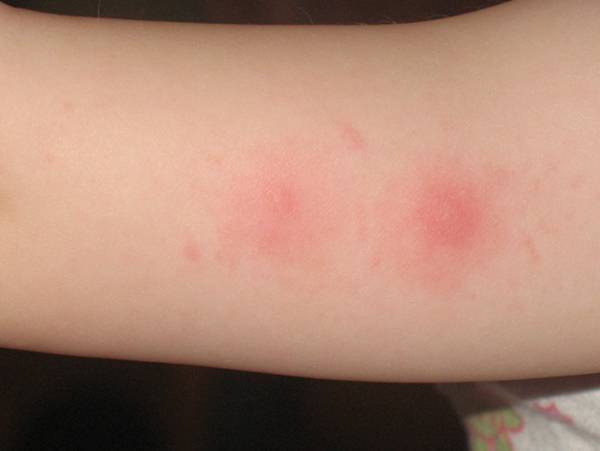
Photo 2. A red papule can be caused by an allergy or some kind of infection.
Medicine does not yet know how to distinguish tuberculosis infection from non-tuberculosis infection. Therefore, recent flu or tonsillitis gives a false positive reaction to the Mantoux test.
Important! When checking Mantoux results, only the size of the papule plays a role. Skin color does not in any way reflect the risk of tuberculosis and is therefore practically unimportant
Big Mantoux: dimensions, what it means
Large Mantoux means a positive reaction to the introduction of tuberculin (mycobacterium particles) into the skin; the size of the compaction in this case always exceeds 5 mm. The more immune cells in the body that have reacted to contact with the tuberculosis bacillus, the stronger the reaction will be. The following results stand out:
- weakly positive – 5-9 mm;
- medium intensity – 10-14 mm;
- pronounced – 15-16 mm;
- strong (from 17 mm to 18 years and from 21 mm for adults) or any size with bubbles and darkening, compaction of the lymphatic tract, lymph nodes.
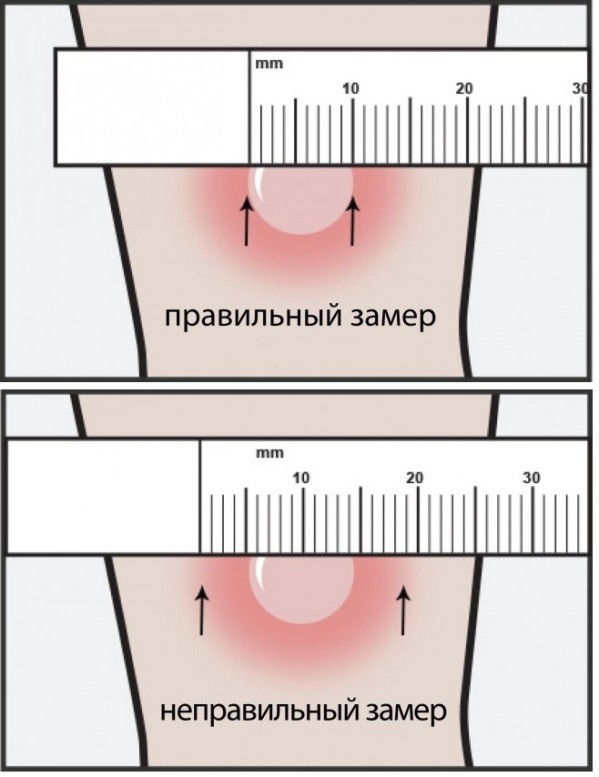
In general, the large size of the papule (a raised area on the skin that becomes lighter when pressed) reflects only the state of the immune system in relation to mycobacterium tuberculosis. There are also false positive results, since tuberculin itself is an allergen. Therefore, for a correct diagnosis, consultation with a phthisiatrician is necessary.
We recommend reading about how many days after Mantoux is checked. From the article you will learn about what day Mantoux is tested in a child, when it is done, the reactions of the Mantoux test, how to check the result yourself. And here is more information about alternative methods for diagnosing tuberculosis in children.
How to correctly assess whether a Mantoux is big
Very often, the size of the entire red spot is taken as the sample size or measured not through the center. Even more important is to take into account the time that has passed since the administration of the BCG vaccine. Therefore, there are age standards when following the vaccination calendar: in the maternity hospital, 7 and 14 years (see table), and they are always compared with previous measurements.
| Age or period from vaccination | No cause for concern (size in mm) | Questionable size in mm | An in-depth examination is required (size in mm) |
| Year | 5-11 (up to 15 if the BCG scar is 10 mm) | 11-16 | From 16 |
| 2 years | Decreased compared to the previous one or the same | Increased by 2-5 mm compared to the previous one | Changed from negative to positive or increased by 5 mm or more |
| 3-5 years | 5-8 or less | Increased by 2-5 mm or the same size | Became positive, increased by 6 mm |
| 6-7 (before vaccination) | 0-4 | 5 | From 6 |
After the next vaccination, all standards are repeated again.
What does a large Mantoux mean per year?
A large Mantoux per year is not always a sign of infection. The first test is carried out at 12 months, subject to BCG vaccination in the maternity hospital. It reflects not so much the risk of infection with tuberculosis bacteria, but the immunity formed after vaccination. Therefore, it is very important to correlate the size of the scar on the shoulder and the diameter of the papule (see table).
| BCG scar size in mm | Dubious Mantoux | Suspicion of infection |
| 6-10 | From 16 | From 17 |
| 2-5 | From 12 | From 16 |
| Up to 2 | From 5 | From 12 |
How to perform a mantoux test in adults
The mantoux test is performed in adults much less frequently than in children and adolescents, but the technique is standard for everyone. The technology for carrying it out is as follows: below the elbow bend of the left arm of an adult, a substance made from the culture of tuberculosis bacteria PPD-L is injected into the skin in an amount of 2 TU (tuberculin units), which is 0.1 mg of solution. In general, there are several types of tuberculin, but in Russia, standard purified tuberculin in 2 ml ampoules is most often used. The substance is absolutely harmless, does not contain a live culture and does not cause infection. The procedure is carried out with a disposable sterile insulin syringe with a very thin needle that painlessly penetrates the skin layer (in no case intramuscularly or subcutaneously). After the injection, the syringe is disinfected and subsequently disposed of.
The test result is recorded three days after the tuberculin injection. For three days, the person where the substance was injected should not get wet, scratched, covered with an adhesive bandage or treated with antiseptics, so as not to distort the readings of the tuberculosis test.
The timing of the tuberculin test is planned in such a way that a month before the test the person does not receive any vaccinations, otherwise the results of the study may not be reliable due to individual characteristics and the body’s reactions to the vaccinations.
Particular attention is paid to the date of the last BCG vaccination
What to do if your hand hurts a lot
Only a doctor can give specific recommendations in case Mantoux hurts badly. However, you should know how you can help in this or that case.
- Hyperergic reaction. If it was she who caused Mantoux’s pain, the child should not treat the injection site with any means. You just need to watch. If there is no fever or other unpleasant symptoms, you should wait for an examination. As a rule, in such a situation, the doctor will prescribe additional examinations. If tuberculosis is detected, treatment will begin in a timely manner.
- Combing. To relieve itching, your doctor will prescribe an antihistamine. The test will have to be repeated after a few weeks.
- Allergy. Antiallergic drugs will help. If the diagnosis is confirmed, then Mantoux will no longer be given to the patient, having selected other diagnostic methods.
- Violation of staging technique. The result obtained is considered false and the test will have to be repeated.
If swelling and pain are accompanied by a high fever, runny nose and cough, it means you have a cold. In this case, the doctor will recommend symptomatic treatment.
When the test was performed with absolute contraindications, the patient will require hospitalization. Absolute contraindications include:
- the presence of an acute infection in the body;
- allergy and high sensitivity to the components of the drug;
- epilepsy;
- skin diseases.
If your hand hurts after Mantoux, it is better not to wait, but rather consult a doctor, especially if the pain is severe, accompanied by fever and a general deterioration in well-being. A specialist will figure out what the reason is and help you cope with unpleasant symptoms as quickly as possible.
Any side effects are a serious reason to think that a mistake has been made. Whoever caused it - the medical staff or the patient himself - needs to eliminate the cause of the complications and redo the test. A reliable result of the Mantoux test is the key to lung health, because timely treatment will help defeat the disease and avoid serious consequences.
What to do if a child scratches Mantu?
Children often scratch the injection site, even if they do not feel itching. The fact is that the button is always noticeable on the skin; it vaguely resembles a mosquito bite. What to do if the Mantoux vaccine itches? The child has a completely normal desire to touch this place, scratch it. As a rule, in such cases nothing bad happens.
But if, after careless touching, the button becomes very swollen and enlarged, it is necessary to deal with it. After all, a large papule will be perceived by the doctor as a positive reaction, and the child will have to undergo additional examinations.
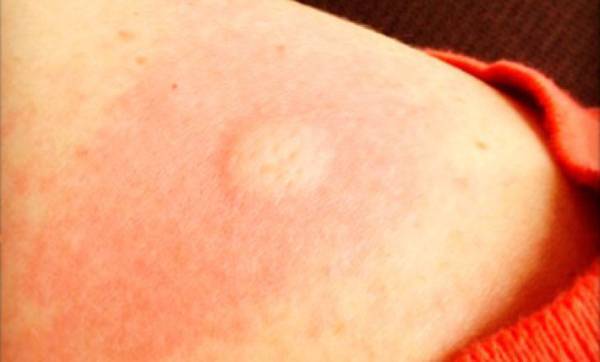
Photo 3. A swollen button, reminiscent of a mosquito bite, that a child scratched may raise suspicion that the reaction is positive.
If a child scratches the Mantoux test and it increases in size, the algorithm of actions is as follows:
- Give your child an antiallergic drug. There is a possibility that he is allergic to tuberculin, so a preventative pill would not hurt.
- Give also an antihistamine. It is better to do this not immediately, but several hours after the antiallergic drug, so that they do not interfere with each other’s work.
- Instruct your child not to scratch the injection site again, and explain the possible consequences. If you convince your child that if the button is large and red, the doctor will force him to give him a few more injections, then the desire to scratch something will disappear by itself.
- If the house is not very hot, dress your child in a sweater or long-sleeved shirt. If he does not see the injection site, then the desire to scratch it will disappear faster.
Important! Bandaging the injection site with a bandage, applying peroxide and cream, and applying ice is not a good idea. Close contact with the fabric will cause the scratched papule to itch even more.
The best choice is clothing with long and loose sleeves.
How to care for Mantoux sample
There are many myths around the Mantoux diagnostic test about what can and cannot be done after the injection. Some of them are really true, others are half true.
How to properly care for the injection site after the test:
- The myth that it is dangerous to wet a sample is false. Of course, prolonged exposure to water and soaking the wound can allow the infection to get under the skin and subsequently result in a false diagnosis. Therefore, wetting Manta is not strictly prohibited, but it is also not recommended.
- The injection site should not be treated with medications or drugs to relieve inflammation until the result is analyzed. The effect of medications may change the child's condition.
- The basic rule is not to scratch the injection site or rub it with a washcloth during hygiene procedures.
- It is also not recommended to tape or bandage the sample site.
In the process of performing the test, although small, damage to the skin occurs, which leads to the risk of infection. An inflammatory process due to the action of foreign elements may be perceived as a positive diagnostic result during evaluation.
Take a free online TB test
0 out of 17 tasks completed
- 1
- 2
- 3
- 4
- 5
- 6
- 7
- 8
- 9
- 10
- 11
- 12
- 13
- 14
- 15
- 16
- 17
Information
This test will help you determine whether you have tuberculosis.
You have already taken the test before. You can't start it again.
You must log in or register in order to begin the test.
You must complete the following tests to start this one:
Categories
- No category 0%
Congratulations! The likelihood that you will develop tuberculosis is close to zero.
But don’t forget to also take care of your body and undergo regular medical examinations and you won’t be afraid of any disease! We also recommend that you read the article on identifying tuberculosis in the early stages.
There is reason to think.
It is impossible to say with certainty that you have tuberculosis, but there is such a possibility; if it is not Koch bacilli, then there is clearly something wrong with your health. We recommend that you undergo a medical examination immediately. We also recommend that you read the article on identifying tuberculosis in the early stages.
Contact a specialist urgently!
The likelihood that you are affected by Koch bacilli is very high, but it is not possible to make a diagnosis remotely. You should immediately contact a qualified specialist and undergo a medical examination! We also strongly recommend that you read the article on identifying tuberculosis in the early stages.
- 1
- 2
- 3
- 4
- 5
- 6
- 7
- 8
- 9
- 10
- 11
- 12
- 13
- 14
- 15
- 16
- 17
- With answer
- With a viewing mark
Does your lifestyle involve heavy physical activity?
- Yes, daily
- Sometimes
- Seasonal (eg vegetable garden)
- No
How often do you take a tuberculosis test (eg Mantoux)?
- I don’t even remember when was the last time
- Every year, without fail
- Once every couple of years
Do you carefully observe personal hygiene (shower, hands before eating and after walking, etc.)?
- Yes, I wash my hands all the time
- No, I don't follow this at all
- I try, but sometimes I forget
Do you take care of your immunity?
- Yes
- No
- Only when sick
- I find it difficult to answer
Have any of your relatives or family members had tuberculosis?
- Yes, parents
- Yes, close relatives
- No
- I can not say for sure
Do you live or work in an unfavorable environment (gas, smoke, chemical emissions from enterprises)?
- Yes, I live permanently
- No
- Yes, I work in such conditions
- Previously lived or worked
How often are you in damp, dusty or moldy environments?
- Constantly
- I'm not there
- Previously was
- Rarely, but it happens
How old are you?
- Under 18
- From 18 to 25
- From 25 to 40
- More than 40
- Woman
- Man
Have you recently felt very tired for no particular reason?
- Very often
- No more often than usual
- I don't remember this
Have you been feeling physically or mentally unwell lately?
- Yes, pronounced
- No more than usual
- No, that didn't happen
Have you noticed a weak appetite lately?
- Yes, there is such a thing, although everything was fine before
- I don't eat much in general
- No, my appetite is fine
Have you recently noticed a sharp decline in your healthy, plentiful diet?
- Yes, I’ve lost a lot lately, although my nutrition is fine
- There is a little, but I wouldn’t say it’s very critical
- I’ve lost a lot of weight lately, but this is the result of proper nutrition!
- No, I didn’t notice this
Have you recently felt an increase in body temperature for a long time?
- Yes, for no apparent reason
- No, that didn't happen
Are you having trouble sleeping lately?
- Yes, this has never happened before
- I have trouble sleeping in general.
- No, I sleep like a baby
Have you noticed increased sweating lately?
- Yes, and very pronounced
- If only a little
- No, that didn't happen
Have you noticed yourself looking unhealthy lately?
- Yes, he's noticeably paler
- No, that didn't happen
Deviation or norm?
If parents believe that the child is one year old and has a large mantu on the arm, then it is likely that this size is the norm. The fact is that 12 months after BCG, the size of the “button” can be 10 mm. For a five-year-old toddler this would be a bad result, while for a one-year-old it would be the absolute norm.
In fact, experts begin to talk about a large manta ray if, at the time of checking the results, the size of the “button” is more than 17 mm. This indicator is called hyperergic and it can indeed be evidence of infection. Also, the fact that infection has occurred may be indicated by a sharp jump compared to last year’s figure, an increase in the size of the “button” by more than 6 mm.
A high result of the mantoux test is not one hundred percent evidence of infection of the body with Koch's bacillus. This can be said in cases where there is an annual increase in this indicator, instead of decreasing or a sharp jump. But even at the same time, one cannot immediately judge the presence of tuberculosis. First you need to undergo additional research.
You will be referred to a TB specialist for consultation in cases where the following factors exist:
- the reaction to manta is a “turn”;
- there is a stable annual increase in the sample rate for several years in a row;
- The child is diagnosed with a large button size.
Hyperemia is the visual absence of any reaction. The skin is without redness and generally looks the same as intact skin. Infiltration - the skin at the injection site is significantly thickened and has slight redness.
Next, the infiltrate should be measured with a transparent ruler, on the basis of which conclusions about the Mantoux reaction are drawn. The reaction happens:
- negative – in the absence of any marks on the skin and redness;
- doubtful - there is slight redness, but there is no compaction at the injection site;
- positive - a small compaction measuring 5 mm or more forms at the injection site. Sometimes the injection mark is a large papule, from 15 mm. This reaction is called strongly expressed.
Parents, not knowing the vaccination standards, often panic or, conversely, ignore the results. You should always listen to your doctor, who will clarify the whole situation.
The Mantoux reaction is negative if there is no thickening or redness in its place. In this case, you don’t have to worry.
A positive test is considered to be a papule exceeding 5 mm. In such a situation, if an increased mantoux is observed, doctors must prescribe a second vaccination for the patient.
A pronounced infection is manifested by the papule exceeding 15 mm, as well as if the injection site has formed a bubble or a crust has formed.
Many mothers begin to panic if the mantu turns red on the first day, but doctors assure that they need to worry when three days have passed. The child may have an allergic reaction and should be given an antihistamine. Experts recommend having less contact with water on the day you are vaccinated and not putting patches on the injection.
It is advisable to limit communication with pets for the time when the vaccination reaction is detected, so as not to provoke increased manta, and reduce the intake of citrus fruits. If the child did not adhere to one of the listed requirements, then this should be reported to the doctor during the examination. If the doctor has doubts, then you need to go through the procedure again.
It’s not easy to understand whether Mantoux turned out “bad” or “good.” It is not enough to estimate the diameter of the papule itself and the degree of its redness. Specialists are also interested in other features of the sample:
- the ratio of the size of the swelling to the size of the post-vaccination scar at the injection site;
- dynamics of research results in comparison with indicators of previous years;
- correspondence of the demonstrated pattern of reaction typical for representatives of this age group.
In what cases should you consult a TB doctor?
Parents are scared if Mantoux turns red on the first day, but to get a diagnosis you need to wait for an examination seventy-two hours after the injection.
Factors associated with a positive answer:
- annual positive reaction to the test;
- the child comes into contact with carriers of the infection (a family member is sick or there are infected people in the school community);
- The size of Mantoux is significantly larger than according to the results of past years.
To confirm or refute the result obtained after the study, the child must be shown to a TB doctor and, if necessary, undergo a repeat test or other prescribed procedures to identify the agents of the disease.
Possible side effects
In most cases, after the administration of tuberculin, a person does not experience any discomfort. But sometimes this procedure can be accompanied by unpleasant symptoms: swelling after Mantoux can be accompanied by redness and itching of the skin, and pain occurs when you press on the injection site.
There may be several reasons for the development of such consequences:
- A severe allergic reaction to the drug or individual intolerance to it, possibly an increase in body temperature.
- When performing the Mantoux test, no contraindications are taken into account. Perhaps this effect occurred as a result of the presence of some kind of infection in the body, or not enough time has passed after recovery.
- The injection site was scratched, resulting in infection in the wound.
Most often, such negative symptoms appear in young children, since it is most difficult to convince them not to touch the “button” and to keep track of it. If a child’s Mantoux is very swollen, it is likely that the injection site was not sufficiently protected, and the baby, scratching the “button,” caused such a reaction.
Visually, Mantoux resembles an insect bite mark, so the child has a natural desire to touch and scratch this place. The easiest way to protect your baby from this temptation is to hide the injection site under clothes with loose long sleeves.
This way the “button” will not attract the child’s attention, and at the same time it will be protected from excessive pressure and friction.
You need to remember that you should not bandage, treat with iodine or brilliant green if the Mantoux is swollen! Such manipulations will not bring relief, but they can spoil the picture of the reaction, which will complicate its further correct assessment by a TB doctor.
The mantoux may become red and very swollen due to an allergic reaction; in this case, antihistamines will help reduce itching and swelling. If a child is susceptible to allergies, it is recommended to take such medications a couple of days before Mantoux and for three days after (before evaluating the results).
If the above symptoms persist for three days (before the sample is examined by a health worker), the patient is sent for further examination to a phthisiatrician.
However, if such symptoms become pronounced, cause severe discomfort, and your hand hurts when you press Mantoux, then there is no need to self-medicate and look for answers on the Internet, trying to establish a “diagnosis from a photo”; in this case, you should consult a doctor without waiting for the date appointed to evaluate the reaction.
Determining test results
What should be the reaction and size of the papule in order to give a negative diagnostic result?
After the injection of tuberculin, redness after Mantoux and the appearance of compactions in the tissues near the injection site are possible. The result of the procedure is usually determined seventy-two hours after the introduction of the allergen.
Possible manifestations:
- hyperemia - a condition in which the external deviation from the norm is slight redness of the tissue around the injection;
- infiltration is a condition in which there is slight swelling or compaction of tissue due to stagnation of blood and lymph, often accompanied by inflammatory processes.
The reaction after the injection may vary depending on compliance with the standards of the diagnostic procedure and the general condition of the patient.
Information that can be obtained after the Mantoux test:
- A negative result is redness around the injection site of no more than one millimeter, without compactions or other undesirable signs.
- A questionable result is redness around the injection site of no more than four millimeters, without tissue compaction.
- A positive result is buttons from five to fifteen millimeters with pronounced tissue compaction.
- A very pronounced result - compaction reaches seventeen millimeters or more.
However, a large Mantoux in a child is not always an accurate diagnosis of tuberculosis. If the Mantoux turns red or signs of swelling appear, there is always the possibility of a false positive result, especially when the baby has previously been vaccinated with BCG.
Assessment of outcome in children
Since the Mantoux test is performed on both children and adults, assessment criteria for people of different ages should also be distinguished.
After the first BCG vaccination, the baby retains a developed immune response to Koch’s bacillus until the age of seven. It is during this period that re-vaccination is carried out.
The reaction rate depending on the child’s age:
- at the age of twelve months (first Mantoux test) to two years, almost all children have a positive or questionable reaction to testing;
- at the age of one year, the size of the button is from five to ten millimeters;
- if at the age of two a child’s vaccination scar reaches eight millimeters, a reaction to a test of up to sixteen millimeters is considered normal;
- at the age of three years and until the age of six, the identification of a questionable reaction continues;
- from four to six years old, the standard sample size is considered to be up to ten millimeters;
- at the age of six to seven years (before re-vaccination with BCG) the reaction is negative;
- from seven to ten years (the first three years after vaccination) a positive result is possible due to the effects of the vaccine;
- upon reaching fourteen years of age the reaction is negative.
The reaction to the test depends on many factors, but BCG remains the main cause of false-positive results in young and middle-aged children. Therefore, after determining a positive reaction, it is necessary to undergo additional research methods.
Outcome assessment in adults
After reaching the age of fourteen, it is customary to undergo fluorography to diagnose tuberculosis, and the Mantoux test is prescribed as an additional diagnostic method.
Normal for an adult:
- negative reaction;
- slight redness regardless of diameter;
- swelling up to four millimeters.
Also, in addition to the Mantoux reaction, various laboratory research methods are used to diagnose tuberculosis in adults.
Changes in reaction by day after injection
Rate of change:
- The reddened button increased in size on the second day and turned red.
- Maximum redness and swelling is achieved on the third day.
Due to the fact that the maximum size of the reaction occurs on the third day after the injection, the measurement is prescribed seventy-two hours after the event.
Symptoms and telltale signs
The rash after Mantoux may look like urticaria or rubella. Only a doctor can correctly determine whether the test is related to such symptoms. But there are clear signs that it was this procedure that caused the reaction in the form of skin rashes.
They are as follows:
- The rash is localized on the limb where the injection was given. In this case, there is no doubt that the sample is to blame.
- The appearance of a rash in the most delicate places - in the folds of the skin, on the stomach and neck.
- Enlarged lymph nodes.
- The presence of other signs of an allergic reaction of the body in the form of fever, loss of appetite.
- If you are intolerant to tuberculin or phenol, the reaction does not occur earlier than within a day, but the symptoms can be severe.
If there is any doubt that the rash is caused by the Mantoux vaccine, doctors conduct clinical and laboratory examinations and identify the cause by exclusion.
But regardless of the cause, an allergy remains an allergy and is always accompanied by a rash. In other words, a rash is the body's first reaction to an outside invasion. And you can’t do without antihistamines.
Allergy to Mantoux
It is not always possible to detect an exacerbation of an allergic reaction to tuberculin before diagnosis. In such cases, an allergic response to Mantoux occurs on the first day and you must consult a doctor to confirm.
Allergies can occur due to:
- individual intolerance to components in the serum;
- hereditary intolerance;
- complications due to chronic diseases;
- dermatitis.
As a rule, in children who are not prone to allergies, an acute reaction to serum components does not occur.
Signs of an allergic reaction:
- Weakness, nausea.
- Vomiting.
- Loose stools.
- Increased body temperature of the child.
- Severe hyperemia.
Also, a change in reaction is possible if precautions are not observed and due to insufficient attention to contraindications.
Antiallergic drugs are a means to combat the disease, but for the safety of the baby it is necessary to undergo alternative diagnostics.[/attention]
Normal Mantoux reaction
The test will determine the presence or absence of tuberculosis pathogens. On the second day after the vaccine is administered, hyperemia appears: the skin area may turn red, there is a small thickening that itches. This .
On the third day, they begin to check the test results: the doctor examines the injection site and measures the size of the papules.
Normal indicators:
- 5-10 mm for infants:
- 18-16 mm for preschool children;
- up to 10 mm for children over 6 years old.
Children over 7 years of age most often experience a negative reaction. This is due to the fact that the body has lost the protection it needs from tuberculosis. In this case, revaccination is carried out.
It often happens that after vaccination there are no signs listed above, including redness without papule. This happens in two cases:
- The immune system did not respond to the mycobacteria that had entered the tissue, which could have occurred due to an incorrectly administered vaccine.
- The immune system is resistant to Koch's bacillus. This is explained by the genetics of the child - most often the parents have relatives who have a similar reaction to the vaccine.
If a negative reaction is observed - an elevated temperature in a child, this can be caused by various factors - from an allergy to the injected substance to inflammatory processes occurring in the body.
The consequences of vaccination in the presence of contraindications can be unpredictable, including an immediate allergic reaction. You cannot perform the Mantoux test:
- for any skin pathologies;
- for epilepsy;
- during the period of exacerbation of chronic diseases;
- with the development of allergic manifestations.
This can cause hematomas, in which the injection site becomes very swollen, an extensive rash appears on the body, and the axillary lymph nodes become inflamed
If the papule becomes very swollen, it is important to consult a doctor immediately
False reaction
A false positive response of the body to the Mantoux test can occur after BCG vaccination. It is given to all children from infancy.
Weakened tuberculosis cells are injected into the body. Later, after the introduction of tuberculin, immunity gives the wrong result. At the same time, the papule turns red, swells, and breaks out.
You can determine that the test result is false by the size of the papules: up to 11 mm there is no need to worry. If the redness at the puncture site reaches 12 mm, this is a positive reaction to the causative agent of tuberculosis.
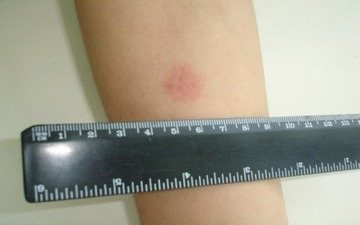
A false reaction to tuberculin occurs in people with weakened immune systems, those suffering from HIV, and in children under 6 months of age. In these cases, the tuberculin test may give a negative result even if infected.
The test should not be combined with vaccinations, especially if the vaccines use live bacteria. At least 2 weeks must pass after the medical procedure.
Otherwise, the test result will be false positive.
For allergy sufferers, during periods of exacerbation of diseases, the Mantoux test is not performed: it will be false positive. Tuberculin is not administered after any medical procedures or during epidemics.
In other cases, Mantoux gives a negative result if there is no infection or contact with Mycobacterium tuberculosis.
Mantu test - nothing to be afraid of
Today, the following topics are pressing for parents: Mantoux test, assessment of results in children. Photos that are found in open sources often amaze the imagination and create wide scope for parental fears. After looking at them and reading information on the Internet, many parents simply refuse to give this vaccination to their children. Although in fact the Mantoux reaction does not apply to vaccinations. With its help, you can find out whether there is a tuberculosis bacillus in the body and at what stage the disease is, if the diagnosis is confirmed. The main task of vaccination is to identify the early stages of the disease. If the Mantoux test result in children is negative, then BCG is given.
The very first Mantoux vaccination is given at the annual return. Until one year of age, the reaction is not detected due to the age-related characteristics of the development of the baby’s body. Infants have very sensitive skin. The result may be unreliable, but it is determined according to certain standards indicating what the Mantoux vaccination should look like. It is also not advisable to do it at 4 months. The child’s balanced diet plays an important role in the test reaction. Therefore, you should carefully monitor his diet.
Mantoux vaccination is done every year, once. For 14 years, children need to undergo this test strictly according to the schedule, because only in dynamics can you see the presence of the disease or identify a predisposition to it.
General information
The Mantoux test (Mantoux test, tuberculin test) is a procedure performed to assess the body’s response to tuberculosis pathogens.
The patient is injected with tuberculin, a drug containing an antigen obtained as a result of deep processing of mycobacteria, which is unable to either infect a person or instill immunity. That is, such a procedure is not a vaccination in the usual sense, it is just a method for diagnosing the disease.
This test is carried out annually for children from one year to 14 years of age (in case of an increased risk of the disease - up to 18 years of age), as well as for some categories of the adult population. Thus, this diagnosis is mandatory for people in contact with tuberculosis patients (living with such patients or doctors) and for people working with children.
Tuberculin is injected subcutaneously into the forearm area, from the inside. The right and left hands alternate with each insertion. The procedure is carried out in a clinic at the place of residence, and for kindergarten pupils and school students, a tuberculin test is performed directly at the educational institution.
Three days after administration of the drug, or more precisely 72 hours later, a medical professional examines the injection area and evaluates the reaction: the general condition, the presence or absence of redness, induration, swelling is taken into account, and also determines the size of the resulting papule (a small dense tumor formed at the injection site ). Its measurement is carried out with a transparent ruler across the arm. The data is entered into the medical record.
The resulting reaction is interpreted as:
- negative;
- doubtful;
- positive;
- false positive.
It should be remembered that any reaction, no matter in what form it appears, cannot clearly indicate infection with tuberculosis. A positive reaction only serves as a reason to prescribe an additional examination by a phthisiatrician.
Alternative diagnostic methods
In addition to the Mantoux test, known since childhood, there are currently other diagnostic methods that are considered more effective in identifying tuberculosis agents.
The most famous of them:
- Diaskintest;
- tubinferon;
- quantiferon test.
In Western countries, more advanced methods of primary diagnosis are used, since Mantoux is characterized by the appearance of a false positive result.
It is also worth noting that, like the tuberculin test, these methods do not provide information about the localization and form of tuberculosis, but only detect the presence of antigens in the human body.
The use of alternative diagnostic methods or repeated diagnostics is prescribed if:
- Positive result of the Mantoux test.
- An allergy appeared before or after the test.
Also, one of the reasons for searching for alternative diagnostic methods is the independent decision of parents.
Diaskintest
Like other medical activities, testing has its good and bad qualities.
It is believed that Diaskintest is a more accurate procedure, the result of which is thirty percent more reliable than the Mantoux test. The diagnostic effect does not depend on previous BCG vaccination or the presence of diseases at the time of the procedure.
The test also provides a negative result in the following cases:
- there are no disease agents in the human body;
- after undergoing therapy and curing tuberculosis.
An allergic reaction to the components of the drug is extremely rare and causes significantly fewer complications (fever, weakness).
Significant disadvantages of the procedure include:
- High cost of the procedure.
- After BCG vaccination, there is still a need to perform a Mantoux test.
In addition to these disadvantages, the method has its contraindications for use.
These include:
- acute condition during bacterial or viral infection;
- detection of epilepsy;
- skin disorders and dermatitis;
- exacerbation of allergies.
Diagnostic assessment is carried out seventy-two hours after the medical event.
Diagnostic rules:
- Approved for use by children from eight to eighteen years of age.
- If the result is positive, re-testing is scheduled after a month.
- If vaccination has been carried out, the test is carried out one month after its administration.
- It is carried out one month after suffering from severe viral or bacterial diseases.
- During observation at a tuberculosis clinic, a test is performed every three to six months.
- If the reaction to the Mantoux test is positive, the test is allowed for use in children under one year of age.
Due to the similar system of implementation, Diaskintest has rules for caring for the injection site similar to the Mantoux test.
Evaluation of results:
- if there is no redness, swelling or thickening of the skin tissue around the injection site - a negative reaction;
- if there is redness without compaction or swelling - doubtful;
- if there is a pronounced inflammatory process around the injection site, characterized by redness, the result is positive.
In addition, it is worth paying attention to the age category of the patient. Since the test is performed not only on children, but also on adults, the size of the redness with a positive result varies.
For an adult patient, a positive result is assessed:
- up to five millimeters - a small amount of tuberculosis agents in the human body;
- up to ten millimeters - average amount;
- more than ten millimeters - a large number of tuberculosis agents.
The results are assessed by swelling and pronounced redness around the injection site. For children, the size of redness with a positive reaction is much smaller.
Tubinferon
Tubinferon is a Russian analogue of Diaskintest. This modified test method combines antigen-based action and the Mantoux diagnostic method.
The advantages of the method are:
- Impact via ESAT-6 and CFP-10 proteins and tuberculin.
- Allows you to assess the condition after BCG vaccination.
Like Diaskintest, it is carried out by injecting a medical solution under the skin.
Interferon test
The name "QuantiFERON" is also found. This test has significant advantages over similar primary diagnostic methods. Its main feature is considered to be that during the study there is no contact with human epithelium, which makes it accessible to people with severe skin diseases.
Main features of the technique:
- Before the study, blood is taken from the patient into three tubes;
- the first is used for analysis;
- the remaining two tubes act as controls;
- Antigens (different from the proteins used during BCG vaccination) are added to the first tube.
The test gives the most accurate result for detecting tuberculosis, but there are not many centers for conducting it. The main laboratories conducting research in this area are located in Moscow and St. Petersburg.
The test helps to identify tuberculosis not only during the active course of the disease, but also in the first stages, when the signs of the disease are nonspecific.
If it doesn't last long
You should know that although the antigen reacts with human blood, it cannot by itself cause bruising. If parents have concerns about a bruise, they need to contact a pediatrician, who in turn will refer you to an appointment with a phthisiatrician. Doctors warn that there is no need to be afraid of bruising after such a test. Unlike brown pigmentation, this condition will not indicate blood poisoning.
A trip to the pediatrician is required when the baby experiences side effects after vaccination. For example, as a result of vaccination, not only does his papule turn purple, but the functioning of the gastrointestinal tract is also disrupted. Sometimes a high temperature also appears. If this condition is one-time in nature, you can give the baby an antipyretic drug
This is Ibuprofen or Paracetamol. In addition, parents should pay attention to other complaints of the child (nausea and headache)
You need to know that a bruise at the site of a mantoux injection itself does not pose any danger and cannot be evidence of a positive reaction to the introduction of a tuberculin test. The occurrence of such a condition can significantly distort the measurement results. In this case, the doctor will ask you to retake the manta in 8 - 12 weeks. Urgent contact with a pediatrician is required in situations where a bruise appears at the vaccination site, turning into a purulent abscess, or the baby complains of severe itching after receiving a mantoux.
You can learn more about why a bruise appears after mantoux by watching the video below:
Normal Mantoux results and deviations
Redness and rashes that were caused by antigens are the body's reaction to the allergen. Therefore, doctors always warn that parents should talk in advance about the fact that the baby is allergic before vaccination. Otherwise, the reaction to the introduction of a tuberculin test may intensify.
The antigen is administered with extreme caution to epileptics, as well as people with skin diseases. Despite the fact that their body’s reaction can be very strong, it will not always mean they are infected with tuberculosis
The following reactions to a tuberculin test are distinguished:
- Hyperergic. In this case, the mantu reaches 1 cm 7 mm. This reaction indicates that the child has recently had an infection or is suffering from tuberculosis.
- Positive. From 5 to 16 mm, which indicate that the baby has immunity from tuberculosis.
- Doubtful. The mantoux on the arm takes up to 4 mm and there is slight redness at the site of the vaccine.
- Negative. In such a situation, there is a seal that takes up no more than 1 millimeter. In addition, a negative mantoux test may indicate that the child is not immune to the disease.
If, after examining the hand, the doctor does not like the reaction to the tuberculin test, the child is referred to a phthisiatrician. This specialist treats tuberculosis. You need to know that sometimes even a hyperergic reaction is not a consequence of the disease. A positive reaction does not mean that a child has tuberculosis. To confirm the diagnosis, doctors perform another test.
Also, if there are any deviations from the norm, the children are registered at the dispensary. Depending on the results after a new test, the child is removed from the register or treatment is prescribed. The conclusion that the baby is not infected is based on the papule, which has retained the same size as before
In addition, during the repeated examination, the phthisiatrician will pay attention to the papule that accompanies the vaccination site
Enlarged Mantoux in a child: reasons, if on the first, second day
To accurately assess whether a child has enlarged Mantoux, it is very important to take measurements strictly on the third day, that is, the first and second are skipped, and measurements are needed after 48-72 hours. It is advisable to maintain the same interval annually and record the result in medical documentation. In case of a doubtful or positive reaction, it is better for parents to keep their notes indicating the time of the test and the interval before the assessment.
What day should the biggest one be on?
The largest Mantu can be on any day before the results are assessed, but all changes before the third day are not taken into account. They can then change either down or up. This is explained by the different speed of formation of the immune response in the child. All intermediate measurements are not needed for diagnosis, because the standard response to tuberculin injection is considered to be only a papule from 48 to 72 hours.
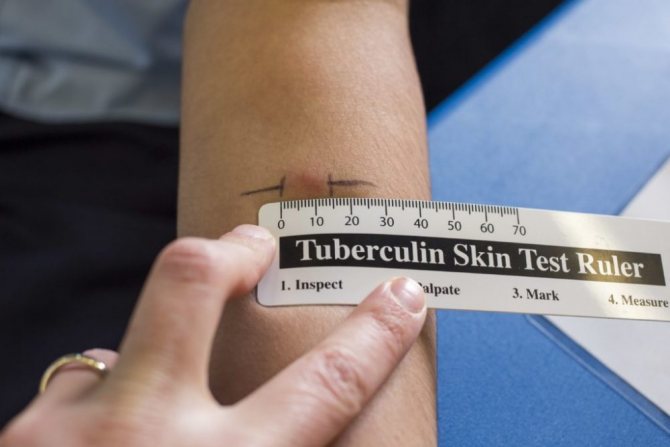
If every year there is a bad reaction
If every year the Mantoux test is positive or doubtful, which parents consider a bad result, then in fact there is no reason to worry. This means that the child’s immunity is sufficiently developed after vaccination. When he is in contact with a patient with tuberculosis, T-lymphocytes will correctly respond to the penetration of mycobacteria into the body.
The truly alarming result is the dramatic change in size compared to the past. You can think about possible infection, for example, if a child had a Mantoux of 12 mm for 2 or more years, and when a new test was performed, the papule became 17 mm in size.
Causes
Let us first note that only a specialist can determine what led to such a reaction. To do this, he will examine the patient, collect anamnesis and possibly prescribe additional examination.
Hyperergic reaction
If the Mantoux is swollen and reddened very much, then they speak of a hyperergic reaction. This phenomenon implies a compaction that is more than 16 mm in diameter in children and more than 21 mm in adults. An abscess, ulcer, and even skin necrosis may also appear at the injection site.
This result may be a sign of active tuberculosis. In addition, if a child does not live in a prosperous area or often comes into contact with infected people (for example, relatives), this indicates the development of immunity.
Incorrect technique for administering Mantoux
If the nurse gave the injection incorrectly, namely:
- did not adhere to sanitary and hygienic standards, as a result of which an infection was introduced;
- administered the drug not intradermally, but subcutaneously;
- used an expired or spoiled vaccine;
- I made a mistake with the dosage.
All of the above is fraught with consequences. Mantu can hurt, fester and become very swollen.
Scratched and infected
The child usually does not notice what he is doing, and sometimes he simply does not understand (due to his age), and begins to rub and scratch the hand where the Mantoux was produced. This is strictly prohibited, as it can cause infection.
By playing outside and touching the injection site, the child creates problems for himself. As a result, pathogenic microorganisms penetrate the wound and begin to multiply. After this, Mantu hurts, the baby becomes capricious and restless. The general condition, accordingly, also worsens.
Allergy
Sometimes such symptoms occur when the child is allergic to the components of the drug. Especially young children, allergy sufferers and those with weakened immune systems are prone to it.
If parents know that the baby is prone to allergic reactions, it is advisable to give the child antihistamines several days before vaccination and exclude allergic foods from the diet.
Other reasons
Can your hand hurt after Mantoux due to something else? Yes. And this may be admission to injection, despite contraindications. This is called medical malpractice. The child must first be examined by a pediatrician, and an adult by a therapist.
- If a person is sick with an infectious disease at the time of the planned tuberculin diagnosis, under no circumstances should he be allowed to see Mantoux. The consequences can be very different, since the immune system is weakened, and at the moment its task is to cope with existing viruses.
- An absolute contraindication is neurological diseases (for example, epilepsy).
- It is also not carried out simultaneously with other vaccinations. At least a month must pass before and after.
- If there are aggravated chronic diseases.
- During extensive skin rashes.
- For allergies (food, seasonal, etc.).
If Mantoux is done, despite the above, then the child’s hand may become inflamed, swollen, and the list of side effects does not end there.


